Menu
Home > How to Stay Healthy By Avoiding Toxins in the Air (with an emphasis on Home Furnishings) – Part 3
***Take 20% off full price purchases*, use code summer24
***Take an extra 5% off products already on sale*, use code XTRA5
*Full details.
Plus, FREE shipping sitewide!
How to Stay Healthy By Avoiding Toxins in the Air (with an emphasis on Home Furnishings) – Part 3
- posted by Corinna
- | July 6, 2023
This is part three in a four part series on how to stay healthy by avoiding toxins. Read parts one and two on avoiding toxins in food and avoiding toxins in water. The main takeaways from part one and two being eat organic whenever possible, and utilizing a water filter is crucial in avoiding toxins in the water. While it is trickier to eliminate chemicals indoors, it is just as important.
In some cases, indoor air pollution is worse than outdoor pollution. Indoor air pollution comes from home building materials as well as the furnishings inside. Small chemical particles evaporate into the air from synthetic building materials, such as particle board (used to build houses), paint, carpet, vinyls and furniture. These small chemical particles are called VOCs. To read more in depth on the science of VOCs, view our article on Low and Zero Voc Furniture.
VOCs are present in the air, which means they are 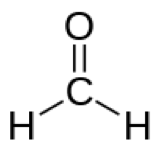 entering the body with every breath. This can have a multitude of negative effects on health. For example, formaldehyde , the most widely known VOC, is a carcinogen and is linked to cancer. Other VOCs often found in home furnishings are benzene (affects the hematological system, the immune system and the nervous system) and toluene (affects the immune system and the nervous system).
entering the body with every breath. This can have a multitude of negative effects on health. For example, formaldehyde , the most widely known VOC, is a carcinogen and is linked to cancer. Other VOCs often found in home furnishings are benzene (affects the hematological system, the immune system and the nervous system) and toluene (affects the immune system and the nervous system).
Furniture and carpet manufacturers are not required to report the variety of VOCs that are emitted from their furniture. This means there is no way to truly know what is being emitted into the air. However, MSDS sheets (Material Safety Data Sheet) on paint and varnishes are typically available. Either way, breathing these compounds are not desired for optimal health.
 The solution? Indoor air quality can be addressed in two main ways, by using an air purification system, and/or by eliminating the source of indoor VOCs. View our air purifiers by Austin Air. In addition to this, opening windows regularly to promote fresh air flow, and growing house plants can be a low cost alternative.
The solution? Indoor air quality can be addressed in two main ways, by using an air purification system, and/or by eliminating the source of indoor VOCs. View our air purifiers by Austin Air. In addition to this, opening windows regularly to promote fresh air flow, and growing house plants can be a low cost alternative.
Since it is easier to replace some factors than others, a mixed approach is likely best. Furniture, carpet, and paint are much easier to change out than the manufactured wood that a house is constructed from. An air purifier will eliminate particles coming from the materials used to construct a house. However, when it comes to the furniture and mattresses that one will be sitting/lounging/sleeping on, it is worth it to replace them with healthy versions. The VOCs coming from furniture are still likely to be inhaled, due to proximity, before they are able to be eliminated by an air purifier.
Finding products with low or no VOCs.
Natural Bed Frames
Most of the furniture on the market is made out of particle board or medium-density fiberboard (MDF). Both particle board and MDF are engineered woods made from wood chips, shavings or even sawdust. This means hazardous adhesives and solvents must be used to hold the wood matter together. These solvents release  VOCs into the air for a long time after being manufactured. Thus, it is important that when seeking a bed frame or furniture, products made from solid wood are the first choice.
VOCs into the air for a long time after being manufactured. Thus, it is important that when seeking a bed frame or furniture, products made from solid wood are the first choice.
Another important component of “wood” furniture is the paint or varnish used as a finish. Paint and varnish can also release VOCs into the air until the varnish or paint is fully cured. Be sure to find a product with a low VOC finish or a product that uses natural oils or wax to protect the wood. By choosing a sustainable, healthy bed frame the amount of toxins in the air and lungs will be significantly reduced.
Organic Mattresses
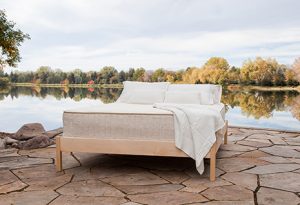 One of the most chemically ridden items in a bedroom is often the mattress slept on every night. Most people spend approximately a third of their lifetime in bed, so it is important to sleep on an organic, natural mattress. All conventional mattresses contain synthetic materials that are made with petroleum (such as polyurethane foam or visco memory foam). These foams release VOCs into the air that are not only carcinogenic, but can also trigger allergies and even respiratory illness. We’ve heard many first hand reports from customers who previously slept on a memory foam mattress getting headaches and waking up with seasonal allergy symptoms, and how this changed upon switching to an organic mattress.
One of the most chemically ridden items in a bedroom is often the mattress slept on every night. Most people spend approximately a third of their lifetime in bed, so it is important to sleep on an organic, natural mattress. All conventional mattresses contain synthetic materials that are made with petroleum (such as polyurethane foam or visco memory foam). These foams release VOCs into the air that are not only carcinogenic, but can also trigger allergies and even respiratory illness. We’ve heard many first hand reports from customers who previously slept on a memory foam mattress getting headaches and waking up with seasonal allergy symptoms, and how this changed upon switching to an organic mattress.
Sofas and upholstered furniture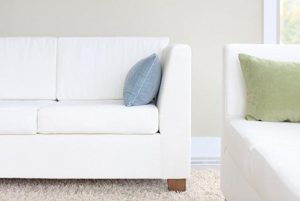
Upholstered furniture like sofas contain not only engineered wood, but also foams for padding similar to conventional mattresses. They also frequently have fabric that is treated with chemicals (when you see advertising for “stain resistant”). An organic sofa is a healthier option for all the aforementioned reasons.
Natural Carpet/Flooring
Carpet is one of the most chemically ridden items that you can have in the home. New carpets can contain several known carcinogens, including formaldehyde, ethylbenzene, acetone, toluene, and styrene. They also contain 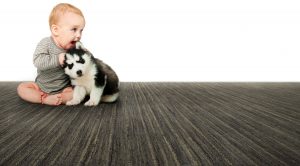 per-fluorinated chemicals (PFCs or PFAS) which don’t break down in the environment or the human body. PFA’s are known as “forever chemicals” because they continue to accumulate until they reach toxic levels. Many PFA’s have been linked to a slew of health concerns that are becoming more apparent year by year. The carpet industry has used PFAS for years to coat carpet yarn for increased stain, soil, and water resistance. These chemicals can break down off of carpet fibers over time and end up in household and office dust, causing concern about their potential toxicity. Natural wool carpet is a healthy alternative. You can read more about natural wool carpet being a good choice in this educational article.
per-fluorinated chemicals (PFCs or PFAS) which don’t break down in the environment or the human body. PFA’s are known as “forever chemicals” because they continue to accumulate until they reach toxic levels. Many PFA’s have been linked to a slew of health concerns that are becoming more apparent year by year. The carpet industry has used PFAS for years to coat carpet yarn for increased stain, soil, and water resistance. These chemicals can break down off of carpet fibers over time and end up in household and office dust, causing concern about their potential toxicity. Natural wool carpet is a healthy alternative. You can read more about natural wool carpet being a good choice in this educational article.
In areas where natural wool carpet is not an option, a solid hardwood is the best choice for a healthy floor. It is important to choose a water-based low VOC floor finish and/ or wait to be around it until it is fully cured to eliminate the most VOCs.
Low VOC Paint
Most mainstream paint manufacturers offer a low-VOC formulation, some even offering a no-VOC formulation. Low or no-VOC holds for the base color (white), however, when tint is added, VOCs are also added. To go all the way natural, choose a milk paint!
Air Fresheners and Fragranced Cleaning Products
Fragranced products used in the home are filled with detrimental chemicals that are known endocrine disruptors as well as being associated with headaches, asthma, and breathing difficulties. Instead, opt for natural essential oils to add fragrance to the home! Also, note that with the use of an air purifier, there may be no need to use an air freshener as the air purifier leaves the air clean and smelling fresh. Cleaning products can also be filled with VOC’s as reported by lung.org. They suggest using safer cleaning products: typically one’s that can be found at your local health food store. Also, check out this EPA page devoted to safer cleaning products. Simpler yet, they suggest using a simple and inexpensive mixture of warm 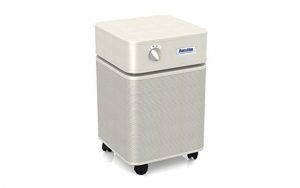 water,soap and,vinegar and/or baking soda for disinfecting and/or scrubbing.
water,soap and,vinegar and/or baking soda for disinfecting and/or scrubbing.
Through a multi-faceted approach of reducing toxins in the home, and using an air purifier to remove toxins not replaced, paired with options like using open windows and growing houseplants, one can be confident they are breathing healthy, clean air.
Read on to our last article in this four part series on how to stay healthy by avoiding toxins in body products.
